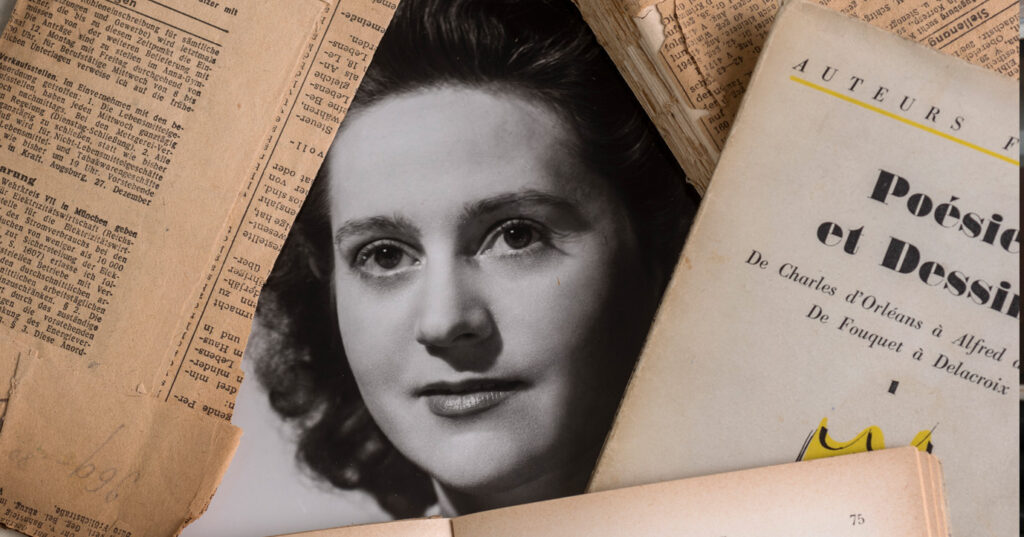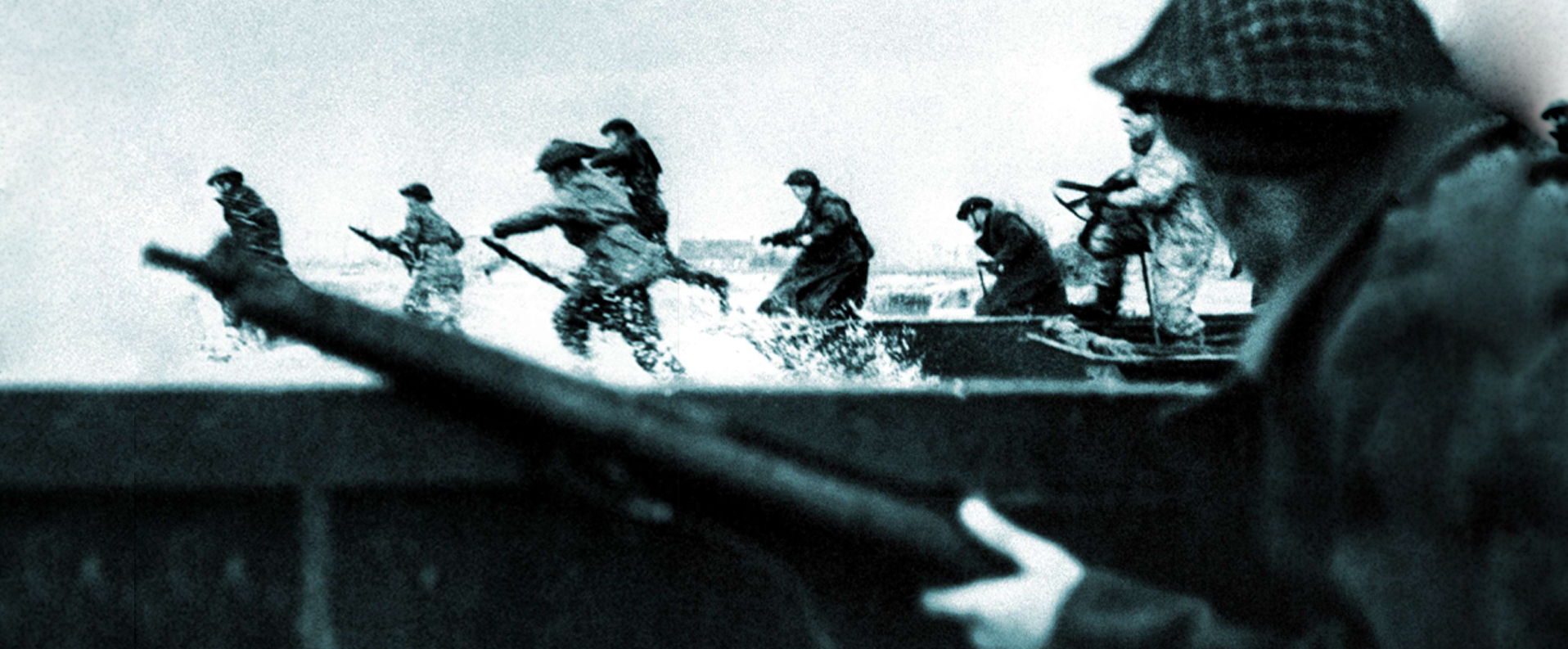
Published in Britain at War in January 2022.
Odette Hallowes/ Odette Sansom GC
They are treasured possessions that shed a new light on how Odette Hallowes, the first woman to receive a direct award of the George Cross (GC), faced her brutal ordeal at the hands of her Nazi tormentors during the Second World War.
A leaf that is nearly 80 years old and deeply private written thoughts, including excerpts from poetry and literature, have been uncovered by Odette’s family more than 25 years after her death.
The leaf and the writings clearly provided huge inspiration to the secret agent whilst she was incarcerated in prison under a death sentence knowing she could be executed at any time.
I have been given special access to the recent discoveries because they will soon go on public display at the gallery bearing my name at the Imperial War Museum (IWM), which already exhibits Odette’s medal group. The gallery houses the world’s largest collection of Victoria Cross (VC) and GC decorations.
The new discoveries were made shortly before the 75th anniversary of the award of the GC to Odette in the summer of 2021. To this day, she remains the only woman to be awarded the GC directly while she was still alive: three other women have received a direct award of the decoration for bravery but their awards were posthumous.
Both the leaf, just an inch and a half long, and the private thoughts and excerpts, beautifully written in pencil, reveal how Odette’s love of nature – along with the prospect of seeing such beautiful sights again – helped her survive her ordeal after she had been repeatedly tortured before spending months in solitary confinement.
The one-time existence of the leaf and the vital role that it played in Odette’s incarceration have long been known to the family because of notes the secret agent shared after her release from prison.
Odette picked up the leaf in late 1944 at Ravensbrück concentration camp in northern Germany. ‘Then, one morning, as I was led after treatment from the Camp hospital back to my cell, the leaf came to me,’ Odette wrote after the end of the war.
‘I was crossing the compound when I saw it lying on the ground. It was a small leaf and I thanked God that I had seen it. I stooped and picked it up. My guards paid little attention. A leaf was not one of the things a prisoner are [sic] forbidden to have and they were totally unconscious of the significance of the treasure I had acquired. They did not know, as they slammed the door of my cell, that I held in my fingers, a most potent link with the forces of life and freedom. As one weary day followed another the leaf became more and more precious to me.’
However, Odette’s family had always assumed that the leaf had been lost or destroyed long ago – until now.
In an interview at her Surrey home, Sophie Parker, Odette’s granddaughter, described the moment that she and her cousin, Mark Samson, found the leaf as they turned the pages of a book – one of three that Odette had managed to hide during her captivity. As a prisoner on death row, she was not permitted such luxuries in her bleak cell.
“My cousin and I were sitting opposite each other at my kitchen table when the leaf just dropped down from the book as we turned its pages. We both just gasped in disbelief. We were speechless before I exclaimed, ‘I just don’t believe it’. It was an incredible moment,” Mrs Parker said.
……………..
Odette Brailly – her maiden name – was born in Amiens, France, on April 28 1912. Her father was killed during the First World War at the Battle of Verdun in 1918, when his daughter was six. As a child, she suffered from polio and rheumatic fever, both of which she overcame and, in 1926, her family moved from Saint-Saëns to Boulogne. She married an Englishman, Roy Sansom, in 1931 and the couple had three daughters, two of whom were born in Britain, where the couple had moved in the early 1930s.
Early in 1942, and nearly three years into the Second World War, Odette heard a broadcast that appealed for photographs of France. She wrote to the War Office explaining that she was French and where she had lived. Odette ended up being asked to attend an interview and, on 28 June 1942, she was asked back to meet Captain Selwyn Jepson, the senior recruiting officer for the Special Operations Executive (SOE), which had been formed in the summer of 1940 after the fall of France.
Jepson’s style was to tell potential recruits: “I have to decide whether I can risk your life and you have to decide whether you’re willing to risk it.” After much soul searching, Odette agreed to work for the SOE. As a cover, she was enrolled in the Women’s Transport Service (“FANY”), while her three young daughters went to live in a convent.
What made Odette willing to give up her children and risk her life as an undercover agent? The key was her sense of duty: she had a deep love of both her French homeland and her adopted country, Britain. She wanted to help the Allied cause and, because she spoke fluent French and knew France well, she concluded that her most valuable role would be working with the Resistance.
In November 1942, she and six other agents were landed in France from a fishing boat. Her code name was “Lise”. On 2 November, she joined up in Cannes with Peter Churchill – codename “Raoul”.
After the Germans and Italians overran southern France, Churchill and Odette were forced to move on and, eventually, they were arrested. Just after their arrest, as they were being transported together, they had secretly agreed that their cover story was that he was related to the British Prime Minister and that they were married. This story probably saved their lives.
Odette was taken to Paris and to the notorious Fresnes prison south of the city. Later, at the German headquarters in 84 Avenue Foch, she endured terrible torture and deprivation. During fourteen brutal interrogations, she stuck to her cover story. She revealed no secrets even when her back was burned with a red-hot poker and her toenails were pulled out one by one.
In June 1943, Odette was sentenced to death on two counts of espionage, to which she replied defiantly, “Then you will have to make up your mind on what count I am to be executed, because I can only die once.”
However, instead of being executed she was taken to Ravensbrück concentration camp, where she was kept in solitary confinement for nearly a year. At one stage, she spent three months and eleven days in underground bunker devoid of all light, day and night.
As the war neared its end, Fritz Suhren, the German camp commandant, decided that handing over Odette might guarantee him lenient treatment from the Allies. However, although he drove her to an American unit, Odette was in no mood to forgive him: in fact, after the hand-over, she returned to his car to obtain papers and photograph albums that were used against him and others at subsequent war crimes’ trials.
During her time in captivity, she had, in particular, refused to reveal the whereabouts of a wireless operator and another British agent who both played a key role in the Resistance. She not only saved the lives of the two men but enabled them to continue carrying out their invaluable work.
After her release, she said she knew the two men’s whereabouts but resisted torture. “I could have told them what they wanted to know just like that,” she said, adding: “I was a woman with a sense of duty.”
Unsurprisingly, Odette’s physical and mental health was frail for some time after the war. Her GC was announced in The London Gazette on August 20 1946. Her lengthy citation ended: “During the period of over two years in which she was in enemy hands, she displayed courage, endurance and self-sacrifice of the highest possible order.” Odette was reunited with her children after the war, but her marriage did not survive.
After the Second World War, she became a national heroine and, for many, the symbol of defiance against the Nazi regime. Furthermore, she was the only one of the three female war agents awarded the GC to survive her ordeal at the hands of the Germans. Two posthumous GCs were awarded to Violette Szabo and Noor Inayat Khan.
In 1947, Odette married Peter Churchill, with whom she had endured so much during their time working with the French Resistance. However, the couple divorced in 1955 and she married Geoffrey Hallowes, who had also fought with the Resistance, in 1956. Hallowes had already been awarded the Croix de Guerre for his “cloak and dagger” actions, while Odette had received the Légion d’Honneur and the MBE.
A biographical film, Odette, starring Anna Neagle, was released in 1950 and the two women became firm friends. Odette died in Walton-on-Thames, Surrey, on March 13 1995, aged eighty-two.
Today her legacy not only lives on but it grows. In February 2012, the Royal Mail released a postage stamp featuring Odette as part of its “Britons of Distinction” series. As recently as March last year, Great Western Railway named a train after her and a ceremony in Odette’s honour was held at Paddington Station and was attended by The Princess Royal.
……………
OVER THE COMING months, the recently-discovered and highly-poignant leaf will go on public display at the IWM, along with the three books that Odette managed to hide away from her prison guards.
Only recently, too, were some of Odette’s intimate thoughts and writings discovered in two of the books – she, of course, had no notebook in which to use, only her squirrelled-away broken lead pencil.
Two volumes of the book “Poésies et Dessins” (“Poems and Drawings”) were secretly given to Odette by Paul Steinert, the priest at Fresnes prison. She used them to write down her thoughts and some of her favourite poetry and literature penned by other authors.
Shortly before her release from Ravensbrück, she was given – by a woman SS guard – a third book which will also go on public display. “The Letters of Katherine Mansfield” was so treasured by Odette that she made a cover for the book from German newspapers which she and other prisoners were given as lavatory paper. She hand-stitched the cover using a needle and thread that she had also somehow acquired in captivity.
Today, thanks to the co-operation of Sophie Parker and her extended family, I can also reveal her new writings, penned in both English and French (Odette was bilingual). They show Odette’s desire to be free, amongst nature. Mansfield, who was brought up in New Zealand, was a modernist writer of the early 20th century.
In one passage, Odette wrote: “I want to live by the spirit of love – love all things, see into things so deeply and truly that one loves. That does not rule out hate, far from it. I mean it doesn’t rule out anger. But I confess, I only feel that I am doing right when I am living by love. I don’t mean personal love, but the big thing. Why should one love? No reason. It’s just a mystery. But it is like light. I can only truly see things in its rays.”
This was, in fact, a quote from writings by Katherine Mansfield, which Odette appears to have copied from the book she was given in prison.
In another quote from a Mansfield letter, Odette wrote down: “One cannot hail solitude as one hails a dark cab. To disentangle oneself completely takes long…”
Other writings were apparently recalled from her widespread love of literature – particularly poetic words that were relevant to her own tragic circumstances.
For example, Odette wrote down this quotation from Saint Joan, the George Bernard Shaw play that premiered in 1923, “You think life is nothing but not being stone dead. It is not the bread and water I fear. I can live on bread. It is no hardship to drink water if the water is clean. Bread has no sorrow for me and water no affliction. But to shut me from the light of the sky and the sight of the fields and the flowers; to chain my feet so that I can never again ride with the soldiers, nor climb the hills; to make me breathe foul damp darkness, and keep from me everything that brings me back to the love of God, when your wickedness and foolishness tempt me to hate Him; all this is worse than the furnace in the Bible that was heated seven times.”
Sophie Parker told me that her family was hugely excited by the discovery of the leaf and the writings. “This once young, fresh, green leaf, which would have been overlooked by most people, took on enormous importance to Odette, giving her comfort and strength because it represented life outside the prison and became a beacon of hope and freedom to her.
“We feel it is very fitting that these significant items, which help to tell Odette’s story of endeavour and bravery, will be seen by the many visitors who come to view her display in the Lord Ashcroft Gallery.”
Download a PDF of the original Britain at War article.
For more information, visit:
LordAshcroftOnBravery.com


